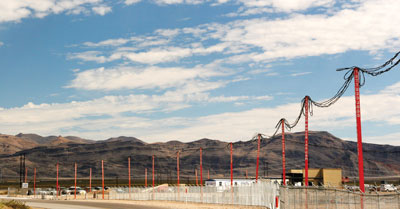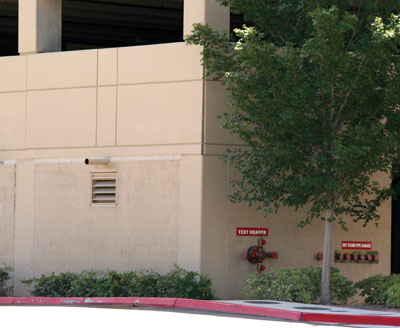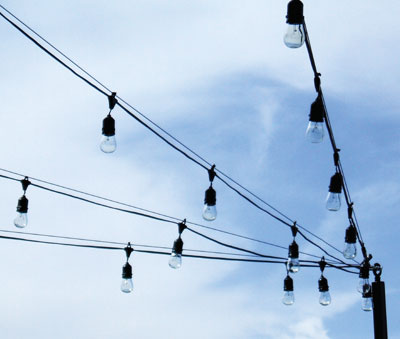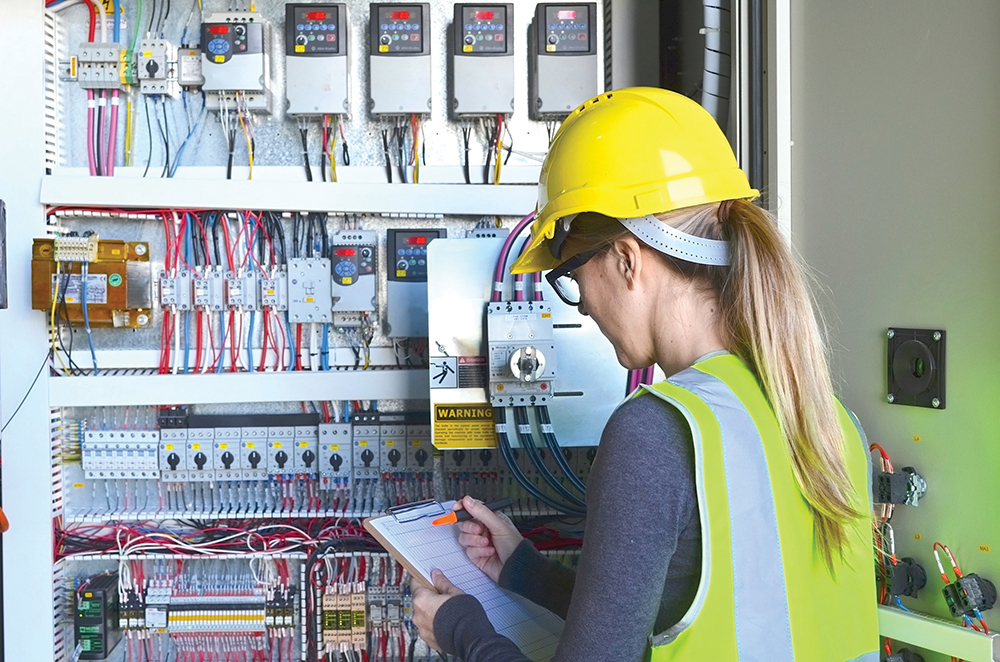Outside branch circuits and feeders — what is so special about these circuits that we require a completely separate article when they are located outside? What makes them different from inside branch circuits and feeders? The scope of this article covers the requirements for branch circuits and feeders running on or between buildings, structure, or poles on the premises, which would also include the wiring for the supply of utilization equipment that is located on or attached to the outside of buildings, structures or poles.

Photo 1. Feeders — any conductors downstream of the main service disconnect is considered a feeder (to the last set of overcurrent devices).
Before we start this article, we need to review just a little. Some of these outside systems may look very similar to and can easily be confused with utility-owned wiring methods. In order to understand the difference between the two, we need to establish where the service point is located. Once this point is found, then anything that is both outside and downstream of the service disconnect would come under the scope of this article.
A new definition has been included to describe a substation. While substations are normally under the control of utilities, in some instances customers are supplied with power at higher than normal voltages from the utility and therefore own their own substations. This has created the need for theNECto include rules for these substations, as they are part of the system past the point of service and therefore under the scope of theNEC. Please review this new definition in 225.2. As with several other articles, in 225.3 we are referred to a table that lists other articles within the code that have additional requirements for specific situations or equipment.
Conductor covering
Moving on to the general requirements, the first item is the requirement for conductor covering, which is required within 10′ of any building or structure other than supporting poles. There is an exception for the grounded or grounding conductor which may still be bare within 10′ of buildings, but only where specifically permitted elsewhere in the code. The ampacity of the conductors for under 600-volt systems will be according to the load as calculated in 220.10 and Part III of Article 220 and then meeting the requirements of Section 310.15. As usual in the code, not all the answers can be found in one location.

Photo 2. Here is the service point for the overhead conductors in photo 1.
By now we should be used to bouncing from article to article to complete an installation. It’s very important to be aware of how the code works and the interaction between various parts of the code. When teaching in a classroom style location, it is actually quite fun to play the game of asking where in the code do we go for this and that as we work through installation scenarios. Even those who are very good at the code will often find themselves searching the code for an exact reference, which they recall but can’t remember exactly where it is located. The more I deal with the code the more I find it important to locate the exact language to ensure I am using that portion of the code exactly as written and not just how I “remembered” it. This became especially critical in the position of AHJ. So the message here is not to feel like you are not good at the code if you can’t quote verse and chapter. We are really challenged because the code is a living document which changes every three years.
Conductor size and support requirements
We now step into 225.6 where we have the conductor size and support requirements. This is broken down into two categories, first Overhead Spans and then Festoon Lighting. Let’s identify where we commonly see these installations.
First, the overhead spans would be wiring going from building to building or pole to pole, usually contained within the confines of one’s property. These may be providing power to detached buildings, wells, signs, area lighting, or other exterior equipment. Depending on the voltage, over 600 volts or below, we are limited to how small the conductor is that may be used for these spans. Over 600 volts requires a minimum of 6 AWG copper, or 4 AWG aluminum, individual conductors; if using a cable assembly, the limits go down to 8 AWG copper or 6 AWG aluminum. For 600 volts or less, we are allowed to use 10 AWG copper or 8 AWG aluminum for spans up to 50 feet, and for spans over 50 feet you are required to step up one size to 8 AWG copper, or 6 AWG aluminum. There is one exception which is the use of a messenger wire, which normally utilizes some type of a steel cable or hybrid wire which has a center strand of steel; in this case, you do not have to increase conductor size when going over 50 feet.
Festoon lightingis not a commonly used term. If we check back in Article 100 we can find the definition, which is: “a string of outdoor lights that is suspended between two points.” This is the lighting method used for outdoor carnivals, flea markets, or holiday sales lots. Here we have the requirement that the conductors not be smaller than 12 AWG unless they are supported by a messenger wire, and if any spans exceed 40 feet then they shall be supported by a messenger wire. It goes further and even tells us how the messenger is to be supported, that being strain insulator devices. We are also told what the conductors or messenger wires may not be attached to; it is not permissible to attach to a fire escape, downspout or plumbing equipment. This makes sense when you consider the issues that may arise if we have a conductor get damaged and short out to the messenger wire, which may then energize a fire escape, downspout or plumbing system and present a dangerous condition. Often, these systems run over long distances and the current needed to have the overcurrent device operate in a timely function may not be optimal, so we can’t take the risk of energizing anything accidentally.


Photo 3. This shows a medical office building where the main service is in the building on the right and the emergency power system and generator are in the parking garage to the left (see inset photo).
In our part of the country (Southern Nevada), festoon lighting was something that we seldom had the opportunity to inspect during most of the year. However, during the fall it seems to come around for Halloween and the holiday season, where we have quite a few pumpkin sales locations and holiday tree lots. These often present several conditions which challenge a good inspector, as they seem to find unique ways to create power and lighting systems, often without the benefit of qualified electrical professionals. As these seasons would come around, I would remind the inspectors to review 225.6(B), to freshen their memory, and hopefully cut down the number of phone calls I would get.
Calculating loads for outdoor installations
Sections 225.7 and 225.8 deal with Lighting Equipment Installed Outdoors and Calculations of Loads 600 Volts, Nominal, or Less. Here we find some limitations depending on the voltages used and references to other code articles for load calculations. Most of this is not out of the ordinary, so we will move on to 225.10 where we have a list of wiring methods which shall be permitted for circuits not over 600 volts on the outside surfaces of buildings. My first question when reviewing this list is, what’s not there? The one wiring method that is definitely not there is nonmetallic-sheathed cable, which when we look it up in Section 334.12(B), we find it’s not allowed to be installed in a wet location. If we review the definition in Article 100, we find that anything on the exterior of a building is considered a wet location due to the fact it is subject to exposure to various types of weather. Another thing to consider is that due to condensation, various wiring methods run outside of buildings are subject to moisture inside conduits, as well as underground installations.
Moving on to 225.11 through 16 we find requirements for conductor entrance and exit from buildings, open conductor supports, spacing, supports over buildings and attachment to buildings. Most of these are simply references to other code articles where we have the language detailing these installations. Most of them refer us to Article 230, Services, which we will cover in the next article in this series.
Outdoor installations often have many similarities whether it is a branch circuit, feeder or service conductors. Some of the installation methods overlap, and the main article used is the one for the most commonly found outside circuit, which is Services, Article 230.
Where violations frequently occur
Next we have to cover a couple of areas where violations occur frequently, Masts as Supports, 225.17 and Clearance from Overhead Conductors and Cables, 225.18. Most of the violations happen in the clearances area. In 225.17 we cover masts as supports and here we find an interpretive term. The language states that where a mast is used as the final span support it shall be of “adequate” strength. First, we have to understand that the final spans are the ones at the end of a run. Those supports in the center of a run have equal tension pulling in two directions, so they basically just need vertical strength; however, the end supports have the pull in just one direction, and therefore have to be strong enough for the lateral pull in one direction. Now what is adequate when you are an inspector? We have run across this issue several times, and locally we just defaulted to the local utility standard, and what they found is that intermediate metallic conduit (IMC) or rigid galvanized steel (RGS) are of sufficient strength for their overhead service drops, so we adopted this standard for outside feeders and branch circuits, as well.
The most critical issue, in my eyes, is the clearance for overhead conductors and cables, which is dealt with in 225.18. We have four basic rules that consider two factors, (1) the voltage of the conductors and (2) the anticipated traffic under the overhead spans. The required distances for clearances are measured from finished grade, sidewalks, or any platform or projection from which the conductors might be reached. Starting out with the lowest clearance, which is 10 feet, this is the minimum clearance for conductors operating at 150 volts or less to ground and subject only to pedestrian traffic. Moving on to condition 2, which is over residential property and driveways and commercial areas not subject to truck traffic, where the conductors operate at 300 volts or less to ground, here we find the minimum clearance at 12 feet. If we have the same conditions but we have a voltage over 300 volts, we make the clearance move up an extra 3 feet to a total of 15 feet. So what have we left out? Only the most important condition, in my thoughts, and that is the area over public streets, alleys, and roads subject to truck traffic; driveways other than residential; and other land traversed by vehicles such as cultivated, grazing, forest and orchard. In these locations, we must maintain an 18-foot clearance no matter what the voltage. A new requirement for the 2011 Code is the clearance requirement over railroad tracks, which is 24.5 feet.

Photo 4. Example of festoon lighting
Continuing with clearances, we next review 225.19, which is titled Clearances from Buildings for Conductors of Not over 600 Volts, Nominal. In (A) Above Roofs, we find the general rule which states that the conductors and cables will be 8 feet above the roof surface and that height shall be maintained for a distance of 3 feet in all directions from the edge of the roof. The main thought here is that the conductors will be high enough that you won’t come into contact when working on a roof. As with many sections of the code, the general rule is followed by several exceptions; and in this case, we have four. I’ll go into detail on one of them and then challenge you to review the rest on your own. In Exception 2, where the roof has a pitch of 4 inches of elevation change in 12 inches of horizontal distance, which makes it quite steep and therefore un-walkable, the clearance may be reduced to 3 feet.
Continuing with clearances in (B) the clearance from signs, chimneys, radio and TV antennas, tanks and other non-building or non-bridge structures, the clearance shall be not less than 3 feet in any direction. This feeds right into (C) which covers horizontal clearances, which also is 3 feet.
The next clearances covered are those for the final span when it is near any windows, doors, porches, balconies, ladders, stairs, fire escapes, platforms, projections or similar surfaces from which the conductors may be reached, bunching all of these together as they require, again, a 3-foot clearance to conductors. With all of these distances and clearance requirements it would just be a natural assumption that conductors should not pass below any openings through which items are moved, and that very requirement is explicitly stated in (D)(3). The most obvious location mentioned is a barn loft through which things are loaded.
Vegetation as Support
Skipping down to 225.26 Vegetation as Support, vegetation such as trees shall not be used for support of overhead conductor spans. This is very commonly violated. For some reason people just have a difficult time telling the difference between a wooden pole and a living tree, I guess.
Raceway Seal
Raceway Seal is a new item in 225.27 added in the 2011NEC. A similar requirement was covered in a previous article, but I think it is important to mention that any underground raceway entering a building shall be sealed.
Supplied by Feeders or Branch Circuits
This brings us to Part II of Article 225, which is Buildings or Other Structures Supplied by a Feeder(s) or Branch Circuits(s). If you are familiar with Article 230 (or have been cheating and reading ahead), you will notice that just about every item in this section is also covered in 230. This further supports the idea that services and outside feeders and branch circuits have many conditions which are the same. With this in mind and to reduce repetition, I will only touch on the unique issues here and we will cover the rest of the basics in our next article.
In 225.30 Number of Supplies, we are informed that only one feeder or branch circuit may supply a building, and of course there are exceptions. Note that for the purpose of this section, a multiwire branch circuit shall be considered as a single circuit. Also, a new item was added for the 2011 Code which states that if a feeder or branch circuit originates at one of these buildings, and is to feed something back in the original building or structure, only one circuit may feed back. This may sound totally confusing, but here is an example: the main building has the normal power service, and therefore has a feeder out to the parking garage, and this feeder goes to a panelboard which feeds all the normal lighting circuits. In this garage is located the emergency generator and the emergency distribution system. It feeds all the emergency lights for the stairs and other areas of the garage, but it also feeds the emergency power for the main building. Well, the code doesn’t allow twenty branch circuits to be fed back to the main building for this application. One circuit or feeder would feed to the main building from the emergency equipment in the garage; and once back at the main building an emergency panelboard would have to be set to feed the individual circuits within that building.
Access to Overcurrent Protective Devices
The last item to cover for 225 is 225.40 Access to Overcurrent Protective Devices, which covers the situation where one may not have ready access to the feeder overcurrent device. This could be for a variety reasons; for instance, you may be a tenant in a separate building on a property under one ownership. When that tenant does not have access to the feeder overcurrent device, the code requires that branch-circuit overcurrent devices shall be installed on the load side of the feeder, that they shall be readily accessible, and — a key point here — they shall be sized smaller than the feeder overcurrent device. The idea here is if you have an issue and a device opens, generally it will open where the tenant has access to it and can restore the power when the problem is solved. This will work most of the time, unless a high-fault current issue happens, which may also take out the feeder device on the line side.
This concludes our discussion of Article 225. Again, I challenge you to open the code and review the actual code language. Time and space certainly limit the amount of coverage possible when writing these articles, so please follow along and fill in the voids. Also, now would be a good time to compare 225 and 230 to see the similarities and be prepared for the next installment when we will dive into Article 230, Services.














Find Us on Socials